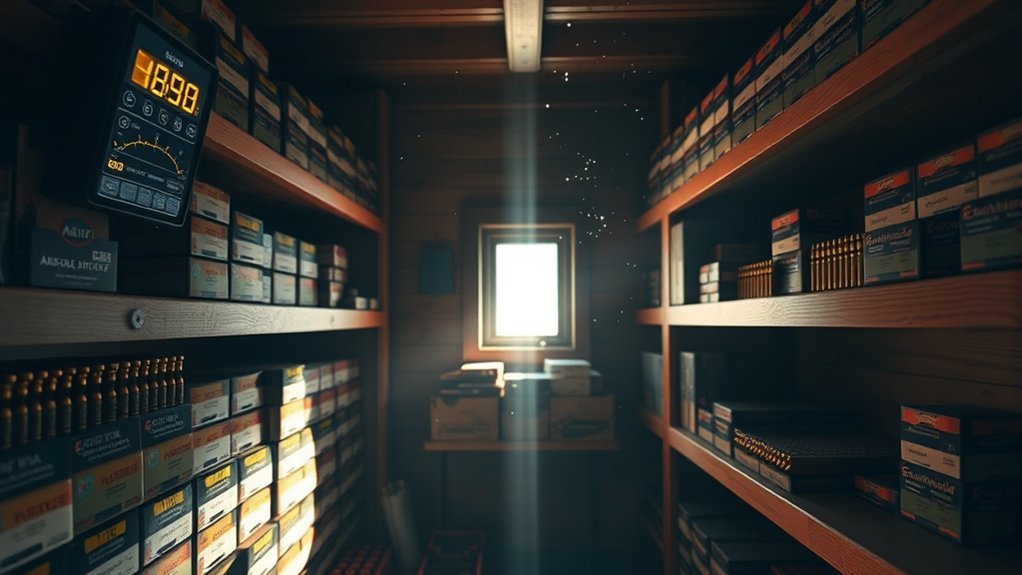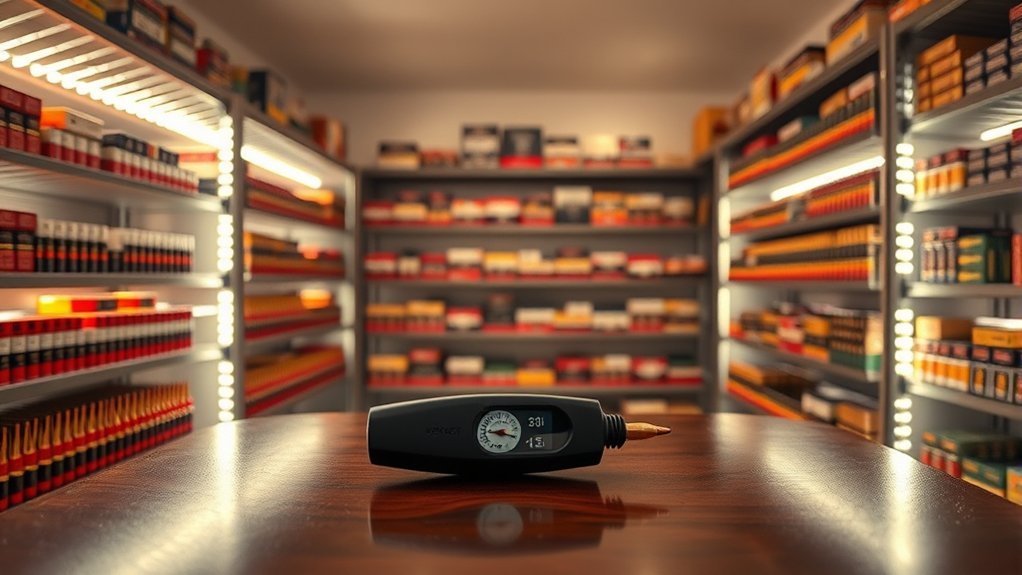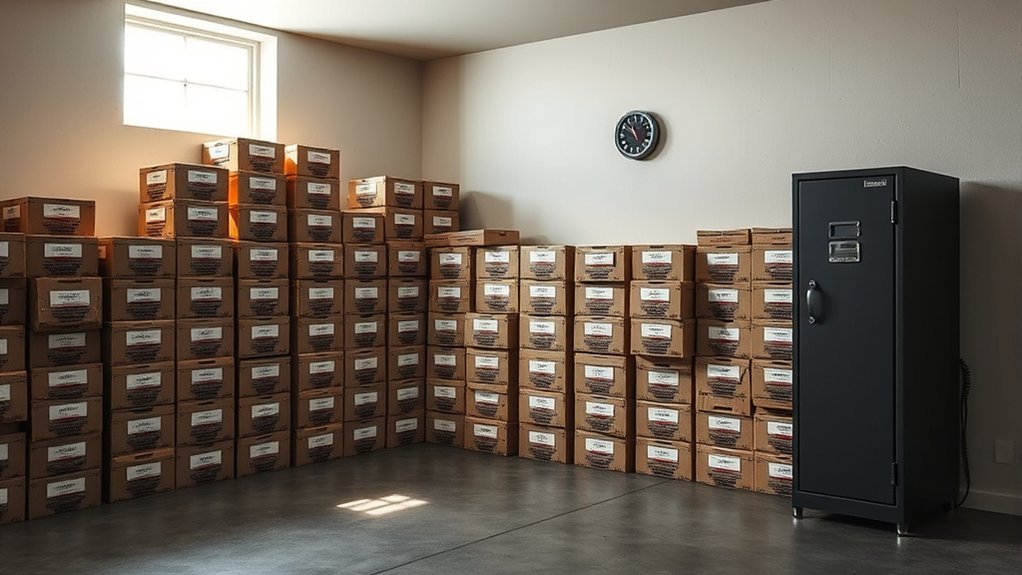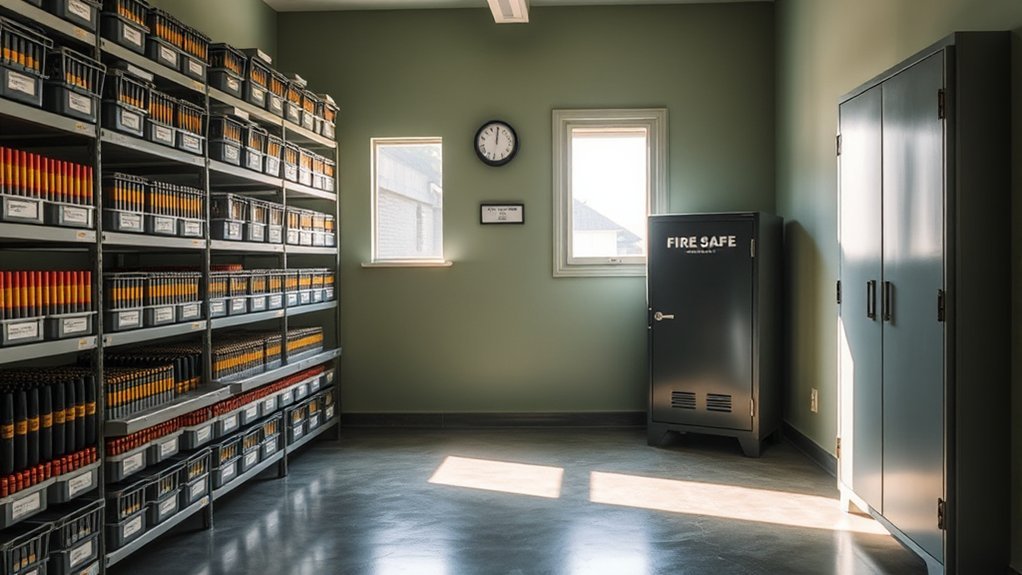When it comes to storing ammunition, understanding temperature and humidity is crucial for safety and performance. You need to keep your ammo in a cool, dry place, ideally between 60°F and 75°F, with humidity levels below 50%. But there’s more to it than just the right environment. Let’s explore best practices and the signs of degraded ammunition to guarantee your supplies remain reliable and safe.
Ideal Temperature Ranges for Ammo Storage

When it comes to storing ammunition, keeping an eye on temperature is essential for maintaining its integrity. Ideally, you should store ammo in a cool, dry place where the temperature ranges between 60°F and 75°F. Extreme temperatures can lead to degradation; high heat may cause the propellant to break down, while freezing temperatures can affect the primers. Avoid areas with direct sunlight or fluctuating temperatures, as these conditions can accelerate deterioration. If you can, use temperature-controlled storage solutions, especially for long-term storage. Regularly check your storage environment to guarantee it remains within the ideal range. By doing so, you’ll help ensure your ammunition remains reliable and performs well when you need it most.
The Impact of Humidity on Ammunition

Humidity plays an essential role in the long-term storage of ammunition, as excessive moisture can lead to corrosion and deterioration. When humidity levels rise above 50%, the risk of rust on metal components increases considerably. This corrosion can weaken your ammunition, affecting its reliability and safety. Additionally, high humidity can cause powder to clump, which disrupts performance and accuracy. To protect your ammo, consider using desiccants in your storage area to absorb excess moisture. Regularly check your storage conditions and keep humidity levels below 50% whenever possible. By managing humidity effectively, you’ll help guarantee that your ammunition remains in prime condition, ready for use when you need it most.
Best Practices for Safe Ammo Storage

When it comes to safe ammo storage, you’ll want to focus on maintaining ideal temperature ranges and controlling humidity levels. Using secure storage containers is essential for protecting your ammunition from environmental factors and unauthorized access. Let’s explore these best practices to guarantee your ammo stays in top condition.
Optimal Temperature Ranges
To guarantee your ammunition remains reliable and safe, it’s essential to store it within ideal temperature ranges. Aim for a consistent environment between 60°F and 70°F (15°C to 21°C). Extreme temperatures can cause deterioration, affecting performance and safety. Avoid placing your ammo near heat sources, like radiators or direct sunlight, as excessive heat can lead to pressure buildup in cartridges. Conversely, freezing temperatures can create condensation when the ammo warms up, risking corrosion. If you’re storing ammo long-term, consider a climate-controlled space to maintain stability. Regularly check the storage conditions and verify that any changes in temperature don’t exceed these recommended limits. Following these guidelines helps preserve your ammunition’s integrity for reliable use.
Humidity Control Techniques
Although you may not think about it often, controlling humidity is essential for safe ammo storage. High humidity can lead to corrosion, rust, and mold, all of which can compromise your ammunition’s performance. To maintain ideal humidity levels, aim for a range of 30-50%. You can achieve this by using silica gel packs or desiccants in your storage area. Consider investing in a dehumidifier if you live in a particularly damp climate. Regularly monitoring humidity levels with a hygrometer can help you stay on top of any changes. Finally, store your ammo in a cool, well-ventilated space, away from moisture sources like basements or bathrooms. By implementing these techniques, you’ll guarantee your ammunition remains in top condition for years to come.
Secure Storage Containers
A secure storage container is essential for protecting your ammunition from environmental factors and unauthorized access. Choose a container made from durable, weather-resistant materials to shield your ammo from moisture and temperature fluctuations. Look for options with locking mechanisms to prevent unauthorized access, guaranteeing only you can access your supplies. Consider a fireproof safe to add an extra layer of protection against heat and flames. It’s also wise to label your container clearly for easy identification while making sure it’s stored in a cool, dry location. Regularly check your ammo for signs of corrosion or damage, and maintain an organized inventory. With these practices, you can guarantee your ammunition remains safe, secure, and in prime condition for use.
Choosing the Right Storage Containers
When it comes to storing ammo, selecting the right containers is essential for maintaining safety and accessibility. Look for containers that are sturdy, waterproof, and resistant to corrosion. Plastic ammo boxes are popular, but metal containers offer extra durability.
Here’s a quick comparison of different storage options:
| Container Type | Pros | Cons |
|---|---|---|
| Plastic Boxes | Lightweight, Affordable | Less durable over time |
| Metal Cans | Highly durable, Secure | Heavier, More expensive |
| Wooden Crates | Aesthetic, Customizable | Less moisture-resistant |
| Ammo Cans | Military-grade, Waterproof | Bulkier, Limited sizes |
Choose based on your needs, ensuring that your ammo stays protected and easy to access when required.
Signs of Degraded Ammunition
When it comes to ammunition, spotting signs of degradation is essential for safety and performance. Look for visual indicators like corrosion, dents, or discoloration on the cartridges. Additionally, conducting performance tests can help identify any issues that may not be immediately visible.
Visual Inspection Indicators
Although ammunition can last for years if stored properly, visual inspection is essential for identifying signs of degradation. Regular checks can help guarantee your ammo remains safe and effective. Look for the following indicators during your inspections:
| Indicator | Description | Action Needed |
|---|---|---|
| Rust or Corrosion | Brown or reddish spots on casings | Dispose or replace |
| Bulging or Dents | Irregular shapes on cartridges | Discard immediately |
| Cracked Casings | Visible cracks on the casing | Discard immediately |
| Faded or Blurred Markings | Illegible labels or data | Replace with new ammo |
| Loose Projectiles | Movement of the bullet in casing | Dispose or replace |
Keep an eye out for these signs to maintain your ammunition’s integrity.
Performance Testing Results
After conducting visual inspections, it’s important to ascertain the performance of your ammunition. You should perform test firings in a controlled environment to determine reliability. Look for signs like misfires, hangfires, or excessive recoil, which indicate potential degradation. Additionally, check for inconsistent groupings on the target, as this may signal compromised accuracy. If you notice any unusual sounds or excessive smoke during firing, those could be red flags. Be mindful of any corrosion or damage to the casing, as that can also affect performance. Always prioritize safety; if your ammo shows any signs of degradation, it’s best to dispose of it properly. Regular performance testing guarantees your ammunition remains reliable and effective when you need it most.
Legal Considerations for Ammo Storage
Understanding the legal landscape surrounding ammo storage is vital for any firearm owner. Laws vary by state and local jurisdiction, so you need to familiarize yourself with regulations in your area. Some states require ammo to be stored in secure containers or separate from firearms, while others have specific guidelines regarding storage locations. It’s also important to know age restrictions for purchasing and possessing ammunition, as these laws differ greatly. Additionally, consider any federal regulations that may apply, especially if you’re transporting ammo. Violating these laws can lead to severe penalties, including fines or imprisonment. Always stay informed about changes in legislation to guarantee your ammo storage practices remain compliant and safe.
Conclusion
To summarize, keeping your ammunition stored properly is like safeguarding a prized possession; you wouldn’t leave a valuable item exposed to the elements. By maintaining the ideal temperature and humidity levels, using durable containers, and regularly checking for signs of degradation, you guarantee your ammo remains reliable and safe. Always stay updated on legal regulations to protect yourself and others. With these practices, you can confidently enjoy your shooting activities while prioritizing safety.

